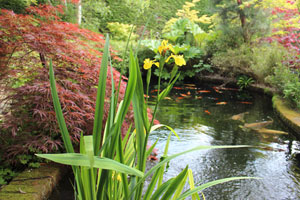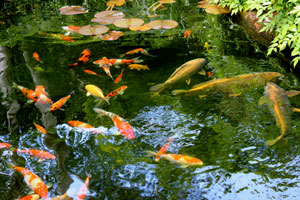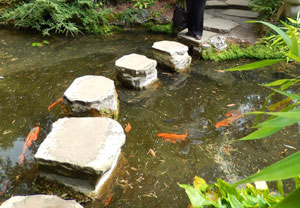Building Koi Ponds and Construction
Japanese Garden Design

Building a koi pond of any size is likely to turn into a major project, with plenty of costs and hard work along the way.
Talking to specialists at aquatic pet shops will likely be helpful and these koi dealers will be very happy to offer advice, since you will probably end up buying fish from them once you have completed your pond.
When done well, this body of crystal clear water and its large, colourful fish can really transform a Japanese garden design, providing the ultimate oriental feature and adding a real sense of nature and character to any landscaped garden.
Modern Pumps and Filter Systems
Over the past few decades, the popularity of koi ponds has grown greatly, thanks to the availability of affordable equipment, such as filters and pumps.

The background noise of a fountain or a gentle waterfall adds a further dimension to any outdoor space.
Not something to be undertaken likely, keeping koi carp can be a challenge and something of a long, lifetime commitment.
These graceful giant fish can become extremely tame, soon eating directly out of your hand. However, before you get out your spade or hire your digger, there is much to think about and plan.
Size and Position
When planning your pond, its size is very much a personal choice. However, for healthy koi carp, a minimum size of 1,500 gallons is sensible (roughly 8 feet long x 7 feet wide x 4 feet deep).

Many fish keeping hobbyists agree that their first pond was too small, while if you make it too large, not only will you not see the fish as much, but your pump will result in a substantial electricity bill each month. Large ponds also make catching any fish a difficult task and when you need to medicate the water, it can also be more costly than a smaller body of water.
Where to place your koi pond in your Japanese garden is another serious consideration, not only from a landscaping point of view, but for the health of the fish and the water quality. Koi ponds are best situated in half-shade or a more shaded area, as this helps to prevent too much algae growth, although some sunlight is necessary. If your only choice is a sunny spot, then a pergola / arbour structure will help to provide some shade, whilst also hiding your pond from hungry herons flying overhead.
Before you start digging, layout the shape with a piece of rope or garden hose, so that you can visualise it for a day or two, viewing it from an upstairs window if possible. Siting a pond near a window or patio area will certainly allow you to enjoy the fish more, rather than hiding it at the end of your Japanese garden. To roughly calculate how many gallons your pond will hold, simply multiply the average length x average width x average depth x 7.5.

Marginal Plants and Water Lilies
People often want to grow plants in their koi ponds, but this can cause some issues and complications. Shelves for marginal plants allow predators to wade in your pond and even when the shelf is filled up with plants, herons can simply stand on them.
Water lilies don't like water movement and sick koi often hide under the lily pads, making these fish difficult to see, although when in flower, there is no denying that water lilies can look really stunning. Introducing plants into your pond can also bring disease and so any plants should first be medicated before they are added to your water.

Construction - Concrete or Liners?
Whether you opt for a rubber or plastic liner (ideally with a concrete collar trench around the edge), or a concrete pond waterproofed with fibreglass or special paint, both have their advantages and costs.
In general, amateur hobbyists find that a liner is the easiest option, while professionals and those with more money to spend on the end result prefer to pay a commercial expert to build their pond from concrete, which has the advantage of having a smoother surface, without the folds that you will undoubtedly have with a liner.
Shape and Bottom Drains
The shape of your koi pond is important, not only so that it fits into the design of your Japanese garden, but for the health of the fish. Make sure that the water will be able to flow around the edges with no dead areas. The contour of the bottom is another consideration, since a flat base will gather settling debris.
If you are installing a central bottom drain, slope the base towards this drain to create a sunken area. When a koi pond is likely to be longer than 16 feet, it will be necessary to install two bottom drains, with two sunken areas for these. Alternatively, you can invest in a more labour intensive pond vacuum to keep the base nice and clean.
 Building a koi pond of any size is likely to turn into a major project, with plenty of costs and hard work along the way.
Building a koi pond of any size is likely to turn into a major project, with plenty of costs and hard work along the way. The background noise of a fountain or a gentle waterfall adds a further dimension to any outdoor space.
The background noise of a fountain or a gentle waterfall adds a further dimension to any outdoor space. Many fish keeping hobbyists agree that their first pond was too small, while if you make it too large, not only will you not see the fish as much, but your pump will result in a substantial electricity bill each month. Large ponds also make catching any fish a difficult task and when you need to medicate the water, it can also be more costly than a smaller body of water.
Many fish keeping hobbyists agree that their first pond was too small, while if you make it too large, not only will you not see the fish as much, but your pump will result in a substantial electricity bill each month. Large ponds also make catching any fish a difficult task and when you need to medicate the water, it can also be more costly than a smaller body of water.
